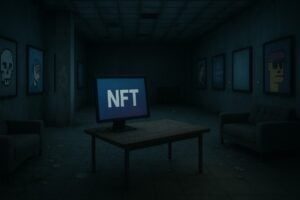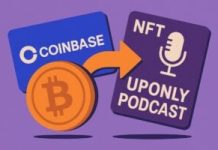Do you remember 2021? It seemed like the whole world was going crazy for NFT art. Social media, digital galleries, million-dollar auctions: everything revolved around JPEGs, GIFs, and animated works sold on the blockchain. It was the new Eldorado of art.
Today, only four years later, that glittering world seems like a distant memory. The market has collapsed. But is it really over? Or are we just entering a new phase?
From the boom to the collapse of the NFT sector: the numbers don’t lie
In the first quarter of 2025, the trading volume in the NFT art market dropped to only 23.8 million dollars. Yes, you read that right: from 2.9 billion in 2021 to just over 20 million today.
According to the data from DappRadar, the number of active traders has also plummeted: from over 500,000 to less than 20,000. A drop of 93%. It’s as if the entire ecosystem suddenly emptied out.
The rise and fall of NFT art
In 2021 everything seemed possible. Unknown digital artists became international stars in a matter of days. Works like “Everydays: The First 5000 Days” by Beeple were auctioned for 69.3 million dollars, making headlines everywhere.
The world was still in lockdown, money was circulating, FOMO was through the roof. And digital art, for the first time, really seemed to have found a home.
But the bull, as we know, sooner or later burst.
“The boom was inevitably temporary. But NFT art is not dead: it is evolving towards more curated and sustainable forms.”,
comments Claire Fenwick, curator and consultant NFT.
From 2022 onwards, the enthusiasm waned. In 2023, the decline began, and 2024 marked the true breaking point.
A crisis told by the data
Here’s a closer look at the numbers:
- Trading volume: from $2.9 billion (2021) → $197 million (2024) → $23.8 million (beginning of 2025)
- Average price per NFT: from $2,044 → $475 in 2023 → slight rise to $1,273 → then down again
- Active traders: from over 500,000 → to less than 20,000
- The top 20 collections of 2021? They have lost 95% of value
It is the end of the quick profit run. The market has purified itself, perhaps even for the better.
Who resisted? The Ordinals on Bitcoin
While Ethereum and Polygon have seen a collapse in volumes, Bitcoin has surprisingly gained ground thanks to the Ordinals: a new form of NFT directly on the BTC chain.
Within the span of a year, the average price of an NFT on Bitcoin has grown by nearly 900%, from $63 to over $630.
“Bitcoin as an artistic layer is a novelty. The Ordinals allow us to explore a different aesthetic and a new form of decentralized ownership.”,
declares Luca Moretti, digital artist on Ordinals.
It is an important signal: the interest in NFT art is not dead, it is simply shifting.
And now? The new trends to watch
While some collectors are leaving the field, others are already looking ahead.
Here’s where NFT art might go in the coming months:
- AI Art: works generated with artificial intelligence are gaining ground, with platforms like BrainDrops and ArtBlocks AI at the forefront.
- Utility NFT: art becomes access, benefits, exclusive experiences.
- Musei digitali: galleries in VR like OnCyber or Spatial are revolutionizing the way of exhibiting and experiencing art.
In short, the market is not dead. It’s just changing its skin.
“`html
Marketplace in difficulty
“`
The platforms have also suffered the backlash. Some of the most famous names of 2021 are now struggling to survive:
- Art Blocks: -95% in volume
- SuperRare: -94% in volume and -98% in sales
- Foundation: practically disappeared
- MakersPlace and KnownOrigin: closed or in the process of closing
Who resisted? Only those who built a true community or a lasting cultural value.
NFT Art: is it really the end?
What we are seeing is not the death of NFT art, but its natural evolution. Away with the flippers, away with the copy-paste projects. The artists who truly believe in it remain. The collectors who are not looking for hype but quality. The works that have something to say.
A bit like it has always been in art, right?
“`html
Conclusion: crisi o rinascita?
“`
Yes, the crash was violent. But perhaps necessary. It cleared the way and opened the path to a new phase, more mature and more interesting.
Million-dollar sales? Perhaps they will remain a rarity. But the space to create, innovate, and collect in Web3 is still there — and perhaps it is even more authentic than before.









